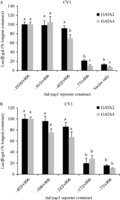GATA augments GNRH-mediated increases in Adcyap1 gene expression in pituitary gonadotrope cells
- Division of Reproductive Endocrinology and Infertility, Department of Obstetrics and Gynecology, University of Texas Southwestern Medical Center, 5323 Harry Hines Boulevard, Dallas, Texas 75390-9032, USA
- Correspondence should be addressed to L M Halvorson; Email: lisa.halvorson{at}utsouthwestern.edu
-
Figure 1
GATA2 and GATA4 stimulate Adcyap1 promoter activity in a dose-dependent fashion. Fibroblast CV1 cells were transiently transfected with a reporter construct containing region −1916/+906 of the rat Adcyap1 gene promoter fused to a luciferase reporter, pGL3. Cells were cotransfected with the indicated amount of expression vector for either GATA2 or GATA4 and with the pSV-β-galactosidase vector to control for differences in transfection efficiency. Luciferase activity was normalized to β-galactosidase activity and expressed as fold-change relative to cells receiving the same amount of empty expression vector. All experiments were performed a minimum of three times with data expressed as the mean±s.e.m.
-
Figure 2
Mapping regions of GATA responsiveness in the Adcyap1 gene promoter. CV1 cells were transiently transfected with various lengths of the rat Adcyap1 promoter–luciferase reporter construct and expression vectors for GATA2 or GATA4. (A) Serial 5′-truncations across region −1916 to +906 relative to the transcriptional start site. Vector only refers to the empty luciferase reporter construct, pGL3. (B) More detailed serial 5′-truncations between positions −402 and −77 relative to the transcriptional start site. Bars with different letters vary significantly within GATA2 or GATA4 results (P<0.05). All experiments were performed a minimum of three times with data expressed as the mean±s.e.m.
-
Figure 3
GATA2 and GATA4 bind to the proximal rat Adcyap1 gene promoter on electrophoretic mobility shift assay (EMSA). (A) Depiction of the putative GATA cis-element and flanking CRE sites in the rat Adcyap1 gene promoter. (B) Binding by in vitro translated GATA2, GATA4, or unprogramed reticulocyte lysate (RL) to a 32P-labeled oligonucleotide probe spanning positions −209 to −167 in the rat Adcyap1 gene promoter. (C) Interaction of GATA2 and GATA4 present in LβT2 gonadotrope nuclear extracts with the −209/−167 oligonucleotide probe. Antibodies directed against GATA2, GATA4, or CREB family members were added to the incubation mixture as indicated. (D) LβT2 nuclear extract was incubated with the WT −209/−167 Adcyap1 oligonucleotide probe and unlabeled oligonucleotide containing the WT sequence or with mutations in the CRE or GATA sites. Oligonucleotide competitors were added at 200-, 40-, and 8-fold molar excess. Shown are representative EMSA which have been performed a minimum of three times.
-
Figure 4
Site-directed mutations in the −191 GATA, −205 CRE, or −179 CRE sites, either singly or in combination, blunt GATA-stimulated Adcyap1 promoter activity. CV1 cells were transiently transfected with GATA2 or GATA4 expression vectors and the full-length (−1916/+906) rat Adcyap1 gene promoter (WT) or constructs containing mutations in the −191 GATA, −205 CRE, and/or −179 CRE sites fused to a luciferase reporter vector. Vector only refers to the empty luciferase reporter construct, pGL3. The response in all mutated constructs was significantly decreased compared with the full-length construct (P<0.001). All experiments were performed a minimum of three times with data expressed as the mean±s.e.m.
-
Figure 5
GATA significantly increases GNRH-mediated stimulation of Adcyap1 promoter activity via the −191 GATA cis-element. Gonadotrope LβT2 cells were transiently transfected with GATA2 (A) or GATA4 (B) expression vectors and sequential 5′-truncations of the rat Adcyap1 gene promoter fused to a luciferase reporter followed by treatment with 100 nM GNRH or vehicle for 6 h. LβT2 cells were transfected with GATA2 (C) or GATA4 (D) and either the WT −1916/+906 PACAP reporter vector or a construct containing a mutation in the −191 GATA site followed by treatment with 100 nM GNRH or vehicle for 6 h. *P<0.001 vs constructs treated with GNRH alone. All experiments were performed a minimum of three times with data expressed as the mean±s.e.m.
-
Figure 6
Effect of siRNA knockdown of GATA2 or GATA4 on GNRH-induced Adcyap1 mRNA expression. LβT2 cells were transfected with 100 nM of a non-targeting siRNA (NTA) or with 100 nM of siRNA directed against GATA2 or GATA4 followed by treatment with 100 nM GNRH for 6 h. Mouse Adcyap1 or siRNA target gene mRNA levels were quantified by qPCR. Results are expressed as percent relative to Adcyap1 expression in the GNRH-treated NTA transfected cells and represent the results from three experiments. *P<0.001 vs non-targeting control siRNA.
- © 2013 Society for Endocrinology












